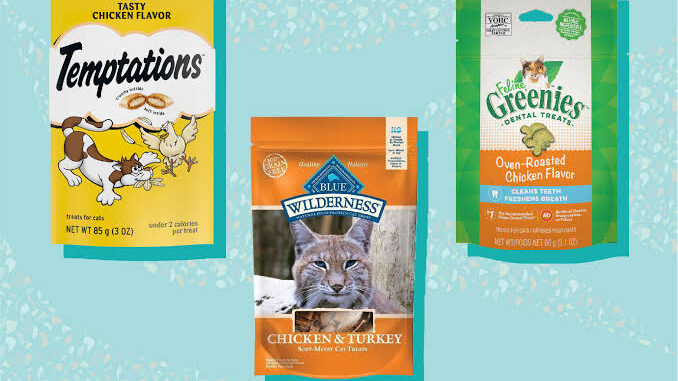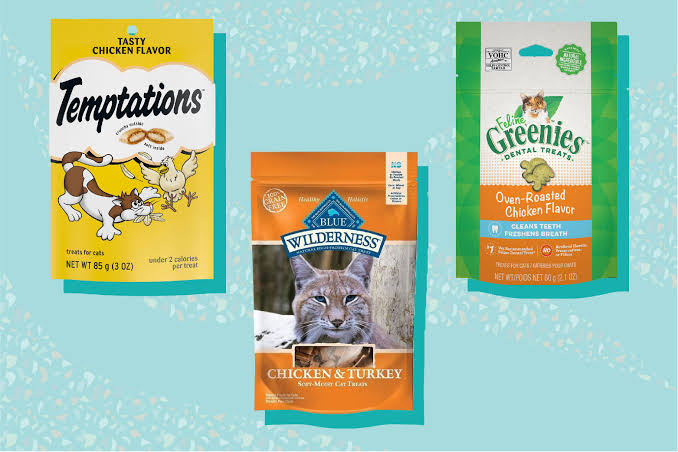
The Best Cat Treats for Training: Cats are often seen as independent, even untrainable. But the truth is cats can absolutely be trained. The secret? The right motivation. And for most felines, that motivation is treats.

Unlike dogs, cats require a bit more coaxing and creativity when it comes to training. That’s where high-value treats come in. This guide will explore the best types of cat treats for training, what to look for in a quality treat, how to use them effectively, and answers to some common questions about treat-based training.
Why Use Treats for Training Cats?
Treats are more than a snack. In training, they serve as rewards that help reinforce behaviors you want your cat to repeat. Positive reinforcement training, when paired with tasty rewards, is:
- Effective: Reinforces desired behavior faster
- Humane: No punishment or fear involved
- Fun: Makes learning a game for your cat
Examples of trainable behaviors include:
- Sitting on command
- Coming when called
- Using a scratching post
- Walking on a leash
- Giving high fives or paw shakes
- Reducing undesirable behaviors (like jumping on counters)
What Makes a Good Training Treat?
Not all cat treats are ideal for training. The best ones share certain characteristics:
Small & Bite-Sized
Cats have small stomachs and short attention spans. A training treat should be small enough to eat quickly without interrupting the flow of the session.
Strong Smell
Cats are scent-driven. A pungent, meaty aroma can grab their attention better than a bland kibble.
Soft & Chewy
Soft treats are easier to eat quickly, especially for kittens or senior cats. Crunchy treats can take too long to chew and may slow down training.
High-Value
This means something special, not part of their regular diet. The more appealing, the better the motivation.
Nutritious & Low-Calorie
Training involves repetition. You don’t want to load your cat with too many calories. Look for options under 3 kcal per treat and use moderation.
Best Types of Cat Treats for Training
Here’s a breakdown of popular and effective categories of training treats for cats:
1. Commercial Soft Treats
These are specifically made for cats and ideal for training sessions.
Top Picks:
- Inaba Churu: A lickable, creamy treat in a tube—cats go wild for it. Great for rewarding while building trust.
- Vital Essentials Freeze-Dried Minnows or Chicken: Pure meat, easy to break into small bits.
- Temptations Creamy Puree: Mess-free alternative to tube treats.
- Wellness Kittles: Tiny, crunchy treats under 2 kcal each. Easy to carry and portion.
Pros: Convenient, varied flavors, available in pet stores
Cons: Can be expensive for daily use
2. Freeze-Dried Meats
These are single-ingredient treats like chicken, turkey, or salmon that have been freeze-dried for freshness.
Top Picks:
- Stella & Chewy’s Freeze-Dried Raw (for cats)
- PureBites Chicken Breast or Shrimp
- Nulo Freeze-Dried Turkey
Pros: High protein, no fillers, cats love the texture
Cons: Can be crumbly, slightly pricey
3. Lickable Treats
Ideal for shy or nervous cats—lickable treats build trust and encourage calm behavior. You can use a spoon, your finger, or squeeze tube.
Brands to try:
- Inaba Churu
- Tiki Cat Stix
- Applaws Lickable Treats
Pros: High-value, excellent for bonding and desensitization
Cons: Messy; not great for trick-based rapid-fire training
4. Homemade Treats or People Food
Use sparingly and only safe items. These can work well if your cat doesn’t respond to store-bought options.
Safe human foods for training:
- Boiled chicken (unseasoned)
- Tiny bits of tuna in water
- Scrambled egg (no salt or oil)
Pros: Inexpensive, customizable
Cons: Perishable, not always easy to carry or portion
5. Low-Calorie Kibble (as Treats)
If your cat is food-motivated but on a diet, use a portion of their daily kibble as “treats.”
Pro Tip: Reserve special kibble for training only, to increase its value.
Pros: Low calorie, no diet disruption
Cons: Less motivating than premium treats
How to Use Treats for Training
Keep Sessions Short
Cats learn best in 2–5 minute sessions. Frequent short bursts are better than one long session.
Choose the Right Location
Minimize distractions. Quiet rooms or familiar spaces work best to begin.
Use a Marker Word or Clicker
Say a word like “Yes!” or use a clicker as soon as the cat does the desired action, followed by a treat. This builds association.
Start Simple
Begin with easy behaviors—like sitting or touching a target. Reward heavily at first, then gradually space out treats as the behavior becomes learned.
Be Consistent
Always reward the correct behavior. Avoid giving treats randomly, or you may accidentally reinforce unwanted actions.
Managing Calories and Overfeeding
Training involves repetition—so treat calories can add up fast.
Tips to stay healthy:
- Break treats into tiny pieces (pea-sized)
- Use part of your cat’s daily food ration
- Track treat intake and adjust meals accordingly
- Choose low-calorie options (under 3 kcal per treat is ideal)
FAQs
How many treats can I give during training?
Keep treat calories under 10% of your cat’s daily caloric intake. For most cats, that’s about 10–20 small treats per session, depending on size and type.
My cat doesn’t like treats. Can I still train them?
Yes. Try different textures, temperatures (some cats prefer cold chicken), or even toys, petting, or praise as rewards. You can also try feeding part of their meal as a training session.
Are dog treats safe for cats?
Not recommended. Dog treats often contain ingredients not suited to cats, such as garlic powder or excess carbs. Always choose cat-specific products or safe, simple meats.
What if my cat is overweight?
Use their regular kibble as a treat. You can also try low-calorie freeze-dried meat or small flakes of tuna or boiled chicken. Adjust meal sizes accordingly.
Can kittens have treats?
Yes, but choose soft, kitten-formulated treats or small pieces of cooked meat. Make sure they’re age-appropriate and always check with your vet for portion advice.
Can I train my cat without treats?
While food is the most effective motivator, some cats respond to clicker training paired with play, toys, or attention as rewards.
Leave a Reply
You must be logged in to post a comment.